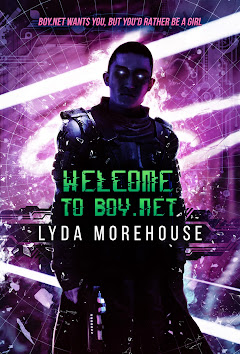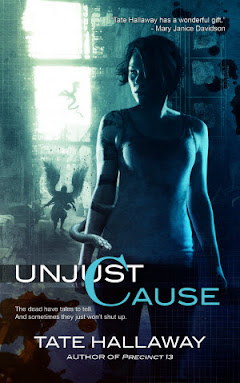In case you missed this over at Riding With the Top Down yesterday, here's it is x-posted here:
What do you do AFTER boy meets girl – or, in my case, after vampire meets witch? The classic set-up of the romance is the first blush, the excitement of falling in love -- so what do you do for a sequel?
That was the question that faced me – and, well, continues to haunt me as I write subsequent books – when starting Dead Sexy (Berkley, May 2007) the follow-up to Tall, Dark & Dead (Berkley, May 2006).
I’ve been in a relationship with the same person for twenty odd years, so, intuitively, I think I sense the romance in the long-term, but how do you write about it – so that it’s interesting? I mean getting him to learn to pick up his dirty socks can be a real challenge, but it doesn’t necessarily make for scintillating reading, you know?
Luckily, the guy in my novels is a thousand year-old vampire, so nothing having to do with Sebastian is typical. Plus, Garnet, our heroine, has a lot of, shall we say, baggage. In other words, before she can even consider settling in with Sebastian, Garnet has to deal with her own crap. In the first book, Garnet had witch-hunters after her, and in Dead Sexy, she’s got an FBI agent hot on her trail. Plus, there’s all that unfinished business with her ex-....
...you get the idea. Even though all these events keep my hero and heroine nearly too occupied to deal with each other, I snuck into the book some of what I consider “real-life” milestones for any relationship. In Dead Sexy, for instance, Garnet and Sebastian have their first fight. It breaks them up a little – hopefully, enough to keep the reader in suspense – and it gives Garnet some time to finally figure out if Sebastian is the one for her.
Garnet is a modern woman, in that she’s in no particular hurry to commit. I think, in some ways, this makes her slightly more difficult for some readers to identify with, but I chose to make Garnet a touch leery about jumping headfirst into a relationship because, well, Sebastian’s not exactly human. And, as odd as this might sound, I wanted my paranormal romance to have a touch of realism, in that the heroine has to consider and weigh all the consequences of a serious, long-term relationship with someone who drinks blood to survive.
For me, that’s one of the appeals of reading and writing urban fantasy. I like to puzzle out the real-life problems of dealing with a fantasy lover. What would it really be like to be married to someone who never ages? If your boyfriend is thirty times older than you are, does he get your references to the Brady Bunch or Schoolhouse Rock? Can people from two fundamentally different eras really breech that gap to fall in love – and, more importantly, stay together?
What about you? How has your favorite author dealt with the question of how to keep a continuing romance hot and spicy and interesting?



1 comment:
I'd have to say at least 4 out of 5 romance writers (paranormal or otherwise) don't deal with the "long-term relationship." If they have sequels; people like Sherrilyn Kenyon, Kerrilyn Sparks, J.R. Ward, Dara Joy, Judith McNaught; start on a whole new couple while things in the macrocosm are still advancing. It's not that our old, happy couples aren't still there, it's that the story no longer takes place through their eyes: there's a soft look during an important strategizing meeting that our new main character(s) will catch, a feeling of longing our new protagonist will have looking at this couple who seems so happy and in love. It's hard to deny the thrill of getting a new relationship going despite insurmountable odds is a hefty allure. We kind of want our favorite characters to just ride off into the sunset.
That being said, I have a lot more respect for authors who tackle the one main character, relationship for the long haul, series idea. First of all, no offense to Ms. Kenyon or Ms. Ward, but what exactly happens after ALL of your Dark Hunters/Brotherhood members are getting spontaneously married off? Every year? In modern times? After 600 years of solitude? How plausible is it really that suddenly, all these centuries-old confirmed bachelors are finding "the one" en masse? And especially in Ward's case, I mean, there are only what, 10 members of the Brotherhood? Less? What happens when they're all married off?
I like the continuity of staying with one character I really like throughout the series, rather then constantly jumping heads. I get a little frustrated when there's information I don't know/can't know from the new character by virtue of who they are and their place in the scheme of things, that I could have easily found out in the head of the character(s) featured in the previous book. I also like forming that deeper relationship with a main character, seeing them through more than one trial in their life, watching them change from better to worse and back again.
But there is that allure of meeting somebody new, of a new romance. I think Laurell K. Hamilton handled it in an interesting way. I mean, Anita Blake has about 10 different guys now, three she could potentially have a deep committed relationship with, and all of them trying not to be at the others' throats for being her lover. That keeps things quite interesting and chaotic on the relationship field, while never having to leave Blake's head. But there's also a part of me that sort of wishes she'd commit to somebody one of these days. I think that's what would make her grow the most as a character.
I really like authors who are willing to tackle the challenges of a series-long, rather than book-long, relationship.
As for Garnet, I love seeing her with Sebastian, trying to get through the everyday trials as well as the paranormal ones. Plus there's always that undead wife on the fringes......
-Mel
Post a Comment